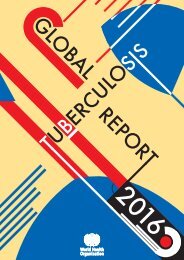patients
DNDi_AR_2015
DNDi_AR_2015
You also want an ePaper? Increase the reach of your titles
YUMPU automatically turns print PDFs into web optimized ePapers that Google loves.
LEISHMANIASIS<br />
R&D MODEL & PORTFOLIO<br />
DEVELOPMENT<br />
New treatments for HIV/VL<br />
co-infection for Africa<br />
PROJECT START: September 2011<br />
OVERALL OBJECTIVE: Develop a new treatment regimen for<br />
<strong>patients</strong> co-infected with HIV/VL<br />
2015 OBJECTIVE: Finalize recruitment into HIV/VL coinfection<br />
study and conduct three interim analyses<br />
59 <strong>patients</strong><br />
recruited at<br />
2 sites<br />
This study, initiated in 2014, aimed to<br />
evaluate the efficacy of a combination<br />
regimen of AmBisome ® with miltefosine,<br />
and of AmBisome ® (at a higher dose)<br />
monotherapy in Ethiopian <strong>patients</strong> co-infected with VL and<br />
HIV. The AmBisome ® monotherapy arm was dropped due to<br />
lower than expected efficacy at the time of the first interim<br />
analysis in April 2015, and recruitment into the remaining<br />
combination arm was also interrupted after the 2nd interim<br />
analysis in July for the same reason. Efficacy and safety<br />
data for the treatment period is currently under analysis.<br />
All 59 <strong>patients</strong> recruited continue the 12 months follow-up<br />
with pentamidine prophylaxis. The final clinical trial report<br />
is expected in 2016.<br />
In anthroponotic transmission areas (where disease is<br />
transmitted by the vector from human to animals), the WHO<br />
recommends secondary prophylaxis with drugs not given in<br />
treating primary VL cases to avoid resistance development.<br />
As part of the Africoleish consortium, the results from a<br />
separate study to assess pentamidine as prophylaxis to<br />
prevent VL relapses in HIV-VL population demonstrated<br />
monthly pentamidine infusions led to lower rates of VL<br />
relapses in HIV co-infected <strong>patients</strong> following one year of<br />
treatment.<br />
MAIN PARTNERS: Gondar University Hospital, Ethiopia; Addis Ababa<br />
University, Ethiopia; London School of Hygiene and Tropical Medicine<br />
(LSHTM), UK; Institute of Tropical Medicine (ITM) – Antwerp,<br />
Belgium; Médecins Sans Frontières (MSF), The Netherlands;<br />
Uppsala University, Sweden; Gilead Sciences, USA; LEAP; The<br />
Netherlands Cancer Institute, The Netherlands; Utrecht University,<br />
The Netherlands; BaseCon, Denmark; UBC, Switzerland<br />
New treatments for PKDL<br />
for Asia/Africa<br />
PROJECT START: March 2015<br />
OVERALL OBJECTIVE: Evaluate the role of PKDL in transmission<br />
and epidemiology of Leishmania parasites and to develop<br />
a new treatment<br />
2015 OBJECTIVE: Carry out preparations for epidemiological,<br />
infectivity, and PK and treatment studies<br />
DNDi is prioritizing the management of PKDL <strong>patients</strong> who<br />
are believed to constitute a reservoir of infection for visceral<br />
leishmaniasis in the Indian Sub-continent and East Africa.<br />
A synopsis has been developed for a Phase II clinical trial<br />
of AmBisome ® alone or in combination with miltefosine,<br />
to assess the safety and efficacy for the treatment of<br />
PKDL <strong>patients</strong> in India and Bangladesh, and AmBisome ®<br />
or paromomycin in combination with miltefosine for the<br />
treatment of PKDL in Sudan.<br />
An infectivity study will also be conducted in both countries,<br />
to explore the role of PKDL as a potential reservoir of<br />
L. donovani parasites which can be spread by the sandfly. This<br />
is of particular concern in the period between epidemics, and<br />
the trial aims to ascertain if there is a need for chemotherapy<br />
for all PKDL <strong>patients</strong> to reduce transmission. It also aims to<br />
identify immunological biomarkers of infectivity in VL and<br />
PKDL cases. In preparation of the study, an insectarium was<br />
constructed at the SK hospital in Mymensingh, Bangladesh<br />
in 2015.<br />
MAIN PARTNERS: International Centre for Diarrhoeal Disease<br />
Research (ICDDR,B), Bangladesh; Rajendra Memorial Research<br />
Institute of Medical Sciences (RMRIMS), India; Kala Azar Medical<br />
Research Centre, India; Institute of Medical Sciences, Banaras<br />
Hindu University, Varanasi, India; Safdarjung Hospital, Delhi, India;<br />
Uppsala University, Sweden; Institute of Endemic Disease (IEND),<br />
Khartoum University, Sudan; Ministry of Health, Sudan; LEAP<br />
DNDi Annual Report 2015 › 33



